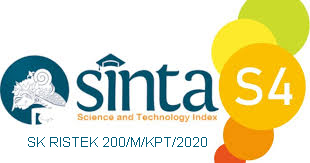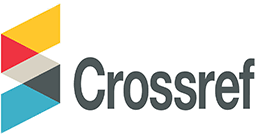Development of Smart Plant Watering System Application Based on Internet of Things
Abstract
In 2024, air pollution levels in Jakarta were recorded as the highest in Southeast Asia, based on various air quality monitoring reports. This condition has become an increasingly alarming environmental issue, with pollution levels frequently exceeding the safe threshold set by the World Health Organization (WHO). One of the efforts by the Jakarta Provincial Government to address this problem is a free plant distribution program for the public. Plants play a crucial role in absorbing carbon dioxide, producing oxygen, and reducing airborne pollutant particles. However, plant maintenance—especially watering—poses its own challenges. Inefficient watering can cause plants to experience stress, wilt, or even die. With the advancement of technology, an automatic plant watering system based on the Internet of Things (IoT) presents a potential solution to improve the efficiency and sustainability of plant care. This study aims to develop a smart plant watering system application based on IoT that can automatically control watering based on real-time soil moisture levels. The system was applied to spider plants (Chlorophytum comosum) grown in pots with a diameter of 15 cm. By using an ESP32 microcontroller, a soil moisture sensor (Capacitive Soil Moisture Sensor v1.2), an air temperature and humidity sensor (DHT11), and a water pump, the system automatically activates watering when the soil moisture is below 55% and stops when it exceeds 65%. Sensor data is stored in a database and displayed through a web-based application for remote monitoring.
Keywords
Full Text:
PDFReferences
“NAFAS Indonesia.” Accessed: Mar. 08, 2025. [Online]. Available: https://nafas.co.id/article/Bagaimana-dengan-kualitas-udara-Jakarta
“Kualitas Udara Jakarta Terburuk Nomor 2 Dunia, Warga Disarankan Pakai Masker - Nasional Katadata.co.id.” Accessed: Mar. 08, 2025. [Online]. Available: https://katadata.co.id/berita/nasional/66e795e7b56ff/kualitas-udara-jakarta-terburuk-nomor-2-dunia-warga-disarankan-pakai-masker
R. Umah and E. Gusmira, “Dampak Pencemaran Udara Terhadap Kesehatan Masyarakat di Perkotaan,” Profit: Jurnal Manajemen, Bisnis dan Akuntansi, vol. 3, no. 3, pp. 103–112, 2024.
“Di Balik Keputusan Pemprov DKI Pakai Lidah Mertua sebagai Solusi Polusi – Jakarta Berketahanan.” Accessed: Mar. 10, 2025. [Online]. Available: https://lingkunganhidup.jakarta.go.id/jakartaberketahanan/?p=16225
M. D. Udin, I. Istiadi, and F. Rofii, “Aquascape Dengan Kontrol Fotosintesis Buatan Pada Tanaman Air Menggunakan Metode Kendali Logika Fuzzy,” Transmisi: Jurnal Ilmiah Teknik Elektro, vol. 23, no. 3, pp. 103–111, 2021.
G. Viroli, A. Kalmpourtzidou, and H. Cena, “Exploring benefits and barriers of plant-based diets: Health, environmental impact, food accessibility and acceptability,” Nutrients, vol. 15, no. 22, p. 4723, 2023.
B. Putra, K. Exaudi, R. Passarella, and P. Sari, “Pemantauan Penyerapan Gas Beracun Menggunakan Tanaman Sansevieria Pada Ruangan Tertutup,” Komputika : Jurnal Sistem Komputer, vol. 11, pp. 95–102, Feb. 2022, doi: 10.34010/komputika.v11i1.4751.
K. P. Cahyanti and D. A. A. Posmaningsih, “Tingkat kemampuan penyerapan tanaman sansevieria dalam menurunkan polutan karbon monoksida,” Jurnal Kesehatan Lingkungan (JKL), vol. 10, no. 1, 2020.
A. D. Haq, A. R. Rahim, and L. A. D. Rahayu, “Potensi sirih gading (Epipremnum aureum) dan lili paris (Chlorophytum comosum) sebagai sarana fitoremediasi PM2. 5 di dalam ruangan,” Jurnal Kedokteran, vol. 10, no. 1, pp. 347–354, 2021.
A. Sumarianti, K. D. Jayanti, and Y. Tanari, “Pengaruh frekuensi penyiraman terhadap pertumbuhan dan hasil bawang merah (Allium cepa L.),” Agrovigor: Jurnal Agroekoteknologi, vol. 15, no. 1, pp. 39–43, 2022.
C. A. Nugroho and A. W. Setiawan, “Pengaruh frekuensi penyiraman dan volume air terhadap pertumbuhan tanaman sawi pakcoy pada media tanam campuran arang sekam dan pupuk kandang,” AGRIUM: Jurnal Ilmu Pertanian, vol. 25, no. 1, pp. 12–23, 2022.
D. E. Nadindra and J. C. Chandra, “Sistem IoT penyiram tanaman otomatis berbasis Arduino dengan kontrol Telegram,” SKANIKA: Sistem Komputer dan Teknik Informatika, vol. 5, no. 1, pp. 104–114, 2022.
R. Alamsyah, E. Ryansyah, A. Y. Permana, and R. Mufidah, “Sistem Penyiraman Tanaman Otomatis Menggunakan Logika Fuzzy dengan Teknologi Internet of Things Berbasis ESP8266 dan Aplikasi Blynk,” Jurnal Informatika dan Teknik Elektro Terapan, vol. 12, no. 2, 2024.
A. Selay et al., “Internet Of Things,” Karimah Tauhid, vol. 1, no. 6, pp. 860–868, 2022.
I. W. B. Darmawan, I. N. S. Kumara, and D. C. Khrisne, “Smart garden sebagai implementasi sistem kontrol dan monitoring tanaman berbasis teknologi cerdas,” Jurnal SPEKTRUM Vol, vol. 8, no. 4, pp. 161–170, 2021.
P. A. Wulandari, P. Rahima, and S. Hadi, “Rancang Bangun Sistem Penyiraman Otomatis Berbasis Internet of Things Pada Tanaman Hias Sirih Gading,” Jurnal Bumigora Information Technology (BITe), vol. 2, no. 2, pp. 77–85, 2020.
A. Yunan, S. Safriati, and H. Hermalinda, “Teknik Penyiraman Tanaman Menggunakan Mikrokontroler Berbasis Internet of Things,” Journal of Information System Research (JOSH), vol. 3, no. 3, pp. 331–337, 2022.
E. Anugrah, M. Hasbi, and M. P. Lukman, “Penerapan Sistem Monitoring Dan Kendali Pintar Untuk Tanaman Terung Berbasis Internet of Things Dengan Metode Penyiraman Irigasi Tetes,” Jurnal RESISTOR (Rekayasa Sistem Komputer), vol. 4, no. 2, pp. 204–212, 2021.
M. I. Hasani and S. Wulandari, “Implementasi Internet of Things (IoT) Pada Sistem Otomatisasi Penyiraman Tanaman Berbasis Mobile,” ILKOMNIKA, vol. 5, no. 3, pp. 149–161, 2023.
M. Darwis, H. A. Al Banna, S. R. Aji, D. Khoirunnisa, and N. Natassa, “IoT Based Early Flood Detection System with Arduino and Ultrasonic Sensors in Flood-Prone Areas,” JURNAL TEKNIK INFORMATIKA, vol. 16, no. 2, pp. 133–140, 2023.
“Metodologi Desain IoT - Tutorial IoT untuk Pemula - Startertutorials.” Accessed: May 07, 2025. [Online]. Available: https://www.startertutorials.com/blog/iot-design-methodology.html
DOI: https://doi.org/10.31326/jisa.v8i1.2208
Refbacks
- There are currently no refbacks.
Copyright (c) 2025 Adnan Nuur Bachtiar, Mochammad Faisal, Muhammad Darwis

This work is licensed under a Creative Commons Attribution-ShareAlike 4.0 International License.
JOURNAL IDENTITY
Journal Name: JISA (Jurnal Informatika dan Sains)
e-ISSN: 2614-8404, p-ISSN: 2776-3234
Publisher: Program Studi Teknik Informatika Universitas Trilogi
Publication Schedule: June and December
Language: English
APC: The Journal Charges Fees for Publishing
Indexing: EBSCO , DOAJ, Google Scholar, Arsip Relawan Jurnal Indonesia, Directory of Research Journals Indexing, Index Copernicus International, PKP Index, Science and Technology Index (SINTA, S4) , Garuda Index
OAI address: http://trilogi.ac.id/journal/ks/index.php/JISA/oai
Contact: jisa@trilogi.ac.id
Sponsored by: DOI – Digital Object Identifier Crossref, Universitas Trilogi
In Collaboration With: Indonesian Artificial Intelligent Ecosystem(IAIE), Relawan Jurnal Indonesia, Jurnal Teknologi dan Sistem Komputer (JTSiskom)
JISA (Jurnal Informatika dan Sains) is Published by Program Studi Teknik Informatika, Universitas Trilogi under Creative Commons Attribution-ShareAlike 4.0 International License.


















